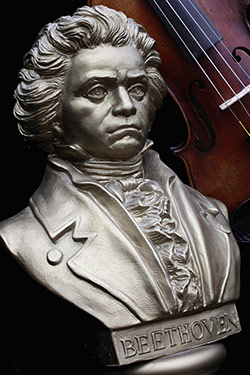
The Association of Adult Musicians With Hearing Loss held its first New York concert recently, at the Bruno Walter Auditorium in Lincoln Center, with a program entitled “Incredibly Musical and Significantly Deaf: More Music With Less Hearing.”
Charles Mokotoff, a classical guitarist who has a day job working in IT with the National Institutes of Health, was up first. Among his pieces was one by Edin Solis, a young Costa Rican composer whom Mokotoff communicates with via e-mail. Later, Jennifer Castellano played a tonal piece called Spectrum, Seven Preludes for Piano, which she composed after seeing Spectrum V, a painting by Ellsworth Kelly, at the Metropolitan Museum. It was reminiscent of the more percussive sections of Keith Jarrett’s 1975 improvisations in Köln, Germany, though more optimistic. If you had walked in during either performance, you wouldn’t have guessed that either performer was deaf or hearing impaired.
Last up was Jay Alan Zimmerman, a pianist who recently composed the Incredibly Deaf Musical. It’s a show based on his path from promising young composer who had a little buzzing in his ears to a gradually deaf person who can hear only the piano keys south of middle C (and not even all of them). He brought several Incredibly Deaf cast members onstage (only one was deaf). They performed a song about what it’s like to be married to someone who suffers hearing loss. (“Honey, you spelled annul wrong,” Zimmerman joked. “Oh, you did mean anal.”) Zimmerman sang one about his debate over whether he should give up music.
During the postshow question-and-answer session, a non-hearing-impaired person asked how the musicians know they are playing a note right when practicing. “I don’t know it’s right,” Zimmerman said. Castellano, referring to the piano, said, “I’m lucky to play an instrument that, if it’s out of tune, it’s really not my fault.” The crowd laughed. She said she adjusts her tone and volume by changing her posture.
As is the case at non-hearing-impaired concerts, some of the Q’s sounded a lot like A’s. “I come from a family of deaf musicians—my mother was a deaf musician and my grandmother was a deaf musician,” one woman said. “I am not a musician, but I have cochlear implants, and I go to deaf functions where there’s karaoke, and it’s horrible.” More laughter.
Finally, the musicians were asked to discuss the difference between hearing a note and feeling it. “I used to write on a synthesizer, but when my mother died, she left me her grand piano, and that worked better,” Zimmerman said, “and part of the reason is, the wave forms of the sounds are coming at you separately, as opposed to coming at you in one wave, out of a speaker. And you can feel the different sound waves coming at you. That’s why we have people in the audience of my musical hold balloons. You can feel the sound waves in the balloons. You should all try listening to music with a balloon.”
Have good intel? Send tips to intel@nymag.com.